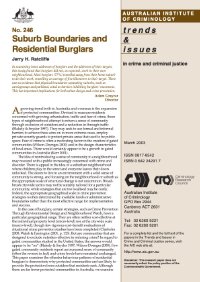By Georgina Fuller
In this paper, four armed robbery profiles have been constructed, based on information contained in qualitative police narratives supplied as part of the AIC’s National Armed Robbery Monitoring Program.
In 2010, approximately 5,000 individuals and organisations reported being the victim of armed robbery. After assault and sexual assault, armed robbery is the third most common violent crime reported; a trend that has remained consistent over the last 10 years (AIC 2013). However, armed robbery is unique when compared with other types of violence due to its overlap with property crime. Specifically, while armed robbery involves the use or threat of force or violence, the primary purpose is to deprive the individual or organisation of their property (Pink 2011). A such, an incident of armed robbery can have both immediate and long-term psychological and economic ramifications for the victim. Therefore, the prevention of armed robbery remains a key focus of business groups,as well as law enforcement agencies.
Previous profiles of armed robbery have almost exclusively focused on the offender. Research conducted in Australia and overseas has examined the characteristics and motivations of offenders in order to explain the variations in robbery (see Gabor et al. 1987; Matthews 2002; Mouzos & Borzycki 2003; Nugent et al. 1989; Walsh 1986). However, while such an approach has merits as an investigative tool, it is limited in its presentation of armed robbery more generally. Specifically, these profiles fail to appropriately capture the influence of the environment and the victim on the offender. It would therefore be useful, when looking to prospectively prevent crime, to broaden this focus and incorporate not just the offender but also vulnerabilities associated with particular victims and/or locations.
Canberra: Australian Institute of Criminology, 2014. 8p.





















